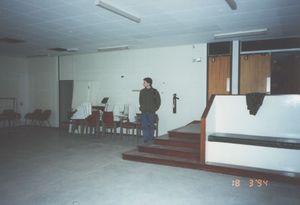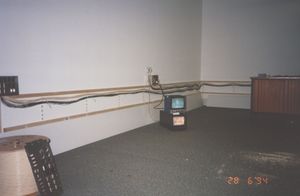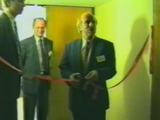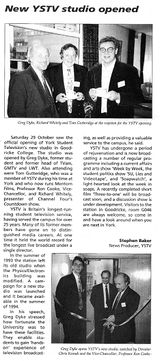YSTV Studio: Difference between revisions
No edit summary |
|||
| (One intermediate revision by the same user not shown) | |||
| Line 65: | Line 65: | ||
The studio was officially opened by [[Greg Dyke]] 29th October 1994. | The studio was officially opened by [[Greg Dyke]] 29th October 1994. | ||
[[Category: YSTV Property]] | |||
Latest revision as of 10:37, 6 May 2020
The room occupied by YSTV has changed throughout the years. Everything on this page I've copied and pasted from the separate articles on the studio, because I thought they would make more sense in one place. Formatting errors may be abound and I'll take some time to make them fit together better.
Chemistry Studio
YSTV began life in the chemistry department. There doesn't seem to be much info about this on the wiki so far. I'll have to do some digging.
P/S/016
This was YSTV's second home after the initial broadcasts from the Chemistry department. Located in the single story Physics laboratory area, this was first set up as a Rediffusion studioUnverified or incomplete information, and connected to LTC directly by the University's CCTV system. It also acted as a switch point for cables coming in from all over the Physics department, intended to allow experiments to be broadcast live around campus.
?? Anything else we know ??
At an unknown point in the late 1970s or early 1980sUnverified or incomplete information YSTV's studio moved to P/X/002 in the Physics concourse underneath the teaching tower block. The move did not leave YSTV completely absent from P/S/016 however, as video and audio going to and from LTC still passed through the equipment racks located there. This continued to be the case after YSTV's move to G/046, and so a minor panic ensued when the room was re-used by the physics department as a computational physics laboratory in 1995??Unverified or incomplete information and the racks removed. YSTV's cables were moved into a vertical cabinet at the side of the room, where they ran unattended until 1999 when the network failed as the last drop of electrolyte evapourated from a 1960's capacitor and the power supply failed. A dash to the Physics stores for a replacement 25p component got the network running within hours.
Entombed in an unmarked cupboard they continued to operate until the next round of refurbishment in 2005, when the mains supply was lost. After a panic and much hunting (no-one had written down where the equipment was), they were found, rewired and replaced to keep YSTV broadcasting to campus.
Today (summer 2007), P/S/016 is used as a nuclear physics laboratory, and is very hard to gain access to due to hazardous stuff, and needing to time it with the lab operators. There is a plan in motion to make a hole in the wall above and to the right of the door (looking at it from the outside) to pull cables through to a box/rack mounted on the wall in the corridoor.
P/X/002
P/X/002 was the home of YSTV from some pointUnverified or incomplete information in the 1970s until June 1993. The room still exists and has since been renamed P/X/003.
It is located within the entrance area of P/X/001, and it now used as storage space. There is little if any evidence that YSTV was ever there from the current appearance of the room. The network broadcast and return feed cables still run through the loft space above the room, and it is used a distribution point to feed signal to TVs located on the Concourse area for Conferences and Freshers week.
When in operation as YSTV's colour studio (October 1986 onwards), the area was split into three rooms in a row. When entering the Station, the first room was used as a workshop and equipment store. This had a doorway which led to the Control Room, which then had another doorway through to the studio.
Prior to 1986, the first room acted as office, workshop and Control Room, and the studio space included what later became the Control Room.
Interregnum
- For more information see Press Clippings from the period and the Closure programme.
The most dramatic upheaval in YSTV's history occurred in June 1993 when the society was forced to vacate its studios and broadcast base in the Physics Department (P/X/002) in order to make way for the expansion of the department and construction of the Exhibition Centre. The centre would need somewhere to store tables and chairs when conferences were in place, and it was decided YSTV's studio would be used for this purpose. YSTV ceased broadcasting (and making programmes) on 19th June 1993.
Impact
At first, the University administration were not inclined to offer any alternative space at all to the society, although there was a suggestion of a move to the York St. John's campus on the other side of the city. After raising a petition on campus, support from the Student's Union and an intervention by Tom Gutteridge, Richard Whitely and Greg Dyke, the society was offered first 600 square feet of space in Wentworth, and then the current 900 square foot studio in Goodricke G/046.
This was not to be available until Spring 1994 however, leaving the society led by Karen Bagley to operate without a base for the intervening period. Whilst major broadcasts like Election Night 1994 and Children In Need 1993 were put out from temporary facilities, regular programme making came almost to a halt with equipment stored in the Physics plant room (S/010), the top of Central Hall, student rooms, and a garage round the back of Wentworth, with Karen Bagley's first floor room in Vanbrugh X block (now Grimston House) acting as temporary office space. However, in an attempt to keep members interested, the society did try to keep Campus Today going on a regular basis, and also made a move towards non-live output such as the Fresher's Guide to Campus (or The Search For Wentworth).
Current Studio
During the summer of 1994 YSTV moved into what was then known as G/046, in what was then Goodricke college (since 'relocated' to East, with remaining buildings on West Campus being reallocated to James college). They were no strangers to this room as it had been used as the control room for Election Night for the two preceding years. The previous occupiers of the room were the Psychology department, now on their way to a purpose built block next to James College. They had tailored it to their own requirements with a series of small partitioned areas within the main room. See the interregnum page for details on the story leading up to YSTV's move into G/046. At this point the SU offices and several other societies were located along the same corridor in Goodricke College so it seemed a sensible place for YSTV to join them.
Conversion
Before YSTV took ownership of the room, it required a significant amount of refurbishment to allow it to function successfully as the studio of a campus television station. The design for the refurbishment was developed in-house at the University of York. Dominic Plunkett provided technical advice to the architect Rory. The large room was divided into two main areas, studio and control room/office area. The studio was soundproofed from the control room by two sets of doors with a short corridor in between. In addition the partition wall between the rooms was made up to two layers of plasterboard. Additional insulation of the rest the studio walls was provided by adding an inner wall of plasterboard some 2" inside the original walls. This meant of course that all the original wiring, wall fittings and so on disappeared behind this wall surface, much to the confusion of later students.
Considerable costs were incurred in removing Asbestos from the ceiling voids and tiles, and in arranging ventelation for the studio, which now had no windows or doors to the outside world. Unfortunately this remains a problem, with the fans being noisy and ineffectual against the heat produced by studio lights in summer.
The design also addressed the issue of electrical safety. The station would consume a great deal of power, especially running the lighting rig in the studio. There would also be substantial amounts of equipment thta must be kept running 24/7 as well as that which needed to be turned off when the station was not in use. An additional mains circuit was installed in the control room which was switched by an RCD near the door. This provided switched power for anything that was not needed 24/7. The two circuits were sometimes referred to as temporary and permanent. In the studio, two rows of sockets were provided, each fed via their own 32A cable from the main distribution boards via RCD switches. Descending from the ceiling void above the rows were a set of mains plugs that were wired back to a series of sockets on the ceiling, used to power the lighting rig. No dimmers were available on the system (due to a lack of funds), so lights were switched on and off via the mains socket switches. Later a 2-channel dimmer fitted with 13A plugs was set up, but could only run a small part of the lighting rig. A proper dimmed installation was finally done in 2002Unverified or incomplete information when a pair of Pulsar Status (6-channel 30A each) dimmers were donated, which are fed from the 32A feed cables and used to feed the lighting rig via IEC patch panels.
Unfortunately during the initial design phase it came to pass that SU Ents Tech required a storage room for their equipment. A section of the raised area next to the entrance way was partitioned off for this purpose. SU Ents Tech treated their equipment with great care. However, once it was within the flight case it was a different story. Frequently, late night operations in the control room would be disturbed by banging and crashing emanating from the Ents Tech cupboard.
This abuse of the wall between Ents and YSTV was brought to a head in 2000 when the damage to the wall caused the "temporary" ring main cable to be broken close to it's connection to the RCD feeding it, which was mounted on this wall. This converted the heavily loaded ring main into a radial circuit with around half the capacity, thus causing it to start smoking shortly before a show was due to go out. The up-side of this damage was that the costs of re-wiring the station (again) were met from the Ents and Safety budgets of the SU not from YSTV funds, despite the fact that the replacement wiring was considerably more flexible. The Control Room was given 3 independent ring mains switched from a new box near the windows, allowing the main equipment to sit on one, and the monitor rack to be split between the other two. This allowed the Cub Conversion colour monitors to be deployed without the switch-on surges tripping the circuits out. The four ring mains are now normally known as CCT1, CCT2, CCT3 and PERM, with a separate CCT4 switched ring available in the studio, independent of the lighting rig and permanent power.
Some programs had been broadcast from the new studio during the summer term of 1994 (for example Week by Week). However, due to other pressing matters (exams) not all the fitment was complete. The studio lacked any organised method of patching signals to and from the studio and control room. Cables were sent directly from equipment in the control room to the corresponding equipment in the studio, leading to a mass of spaghetti at the hole in the wall. During the latter half of the summer term a patching system of cables was devised. A number of connection boxes were spread around the studio and control room. The realisation of the system was greatly assisted by Dominic Plunkett, who managed to obtain a large quantity of high quality connectors from Neutrick and over 450m of PSF coax cable by phoning up and just asking . Each connection box contained 6 female XLR, 4 male XLR, 6 isolated BNC and 2 D9. In the studio, these fed back to the hole in the wall between the studio and control room via a custom built plywood and spruce conduit. The was constructed by Adrian Jones and Owain Davies using the Chris Kwouk's drill. In fact, Chris' drill almost had almost a permanent home in the studio during this time, where it was invaluable in many construction projects. The cables routed back to the main patching panels in the studio next to the hole in the wall and the YSTV rack. Each connector type went onto a different panel (apart from the D9). The cut-outs on the main panels and the connector boxes were made by Paul Hollow and Owain using the punch set on the top floor of Physics/Electronics. Each panel was hinged allowing it to swing open. Somehow Owain ended up with the job of soldering all the connectors to the cables which he did while listening to Ray Cokes on MTV. At the time, some people commented on the strange numbering system for the boxes (9, 8, 7 etc). This was due to an equal quantity of each cable numbering marker being acquired by Owain. Each cable was given a two digit label, connection box number and then cable number. If the boxes were numbered 1,2,3 etc, the numbers at the lower end would have run out, so the connection boxes were given high numbers.
Opening
Move-in occurred during the latter half of the summer term of 1994. Week by Week was one of the first programs to be broadcast from the hastily constructed studio on the 15th June 1994. Although the University had done a grand job in refurbishment, additional touches were required. A control desk and monitor rack was assembled using elements of the racking system from the previous studio. Cable was laid from a central patch bay on the control room side to the set of mini patch panels in the studio via the ceiling void and inside the partition wall between the two rooms, which remains in use today.
The studio was officially opened by Greg Dyke 29th October 1994.




